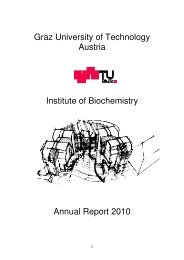Staff Members of the Institute of Biochemistry, TU - Institut für ...
Staff Members of the Institute of Biochemistry, TU - Institut für ...
Staff Members of the Institute of Biochemistry, TU - Institut für ...
Create successful ePaper yourself
Turn your PDF publications into a flip-book with our unique Google optimized e-Paper software.
(master student) investigate whe<strong>the</strong>r alternative covalent modifications in <strong>the</strong> 8�-position are<br />
feasible, i.e. whe<strong>the</strong>r aspartate or tyrosine can form a covalent bond to <strong>the</strong> 8�-methyl group.<br />
In collaboration with Pr<strong>of</strong>. Toni Kutchan at <strong>the</strong> Donald Danforth Plant Science Center in St.<br />
Louis, we have identified o<strong>the</strong>r plant genes that apparently encode flavin-dependent oxidases.<br />
Dipeptidylpeptidase III<br />
Dipeptidyl-peptidases III (DPPIII; EC 3.4.14.4) are Zn-dependent enzymes with molecular<br />
masses <strong>of</strong> ca. 80-85 kDa that specifically cleave <strong>the</strong> first two amino acids from <strong>the</strong> Nterminus<br />
<strong>of</strong> different length peptides. All known DPPIII sequences contain <strong>the</strong> unique motif<br />
HEXXGH, which enabled <strong>the</strong> recognition <strong>of</strong> <strong>the</strong> dipeptidyl-peptidase III family as a distinct<br />
evolutionary metallopeptidase family (M49). In mammals, DPPIII is associated with<br />
important physiological functions such as pain regulation, and hence <strong>the</strong> enzyme is a potential<br />
drug target. Previously, Sigrid Deller and Nina Jajcanin-Jozic have successfully expressed,<br />
purified and characterized <strong>the</strong> recombinant yeast enzyme, and Pravas Baral in Karl Gruber’s<br />
laboratory at <strong>the</strong> Karl-Franzens-University has elucidated <strong>the</strong> crystal structure <strong>of</strong> <strong>the</strong> yeast<br />
protein. This work revealed that yeast DPPIII features a novel protein topology.<br />
Structure <strong>of</strong> human DPPIII in its open form (right) and peptide liganded (closed) form<br />
In collaboration with a structural genomics group in Toronto led by Dr. Sirano Dhe-Paganon,<br />
Gustavo Arruda (PhD student in Karl Gruber’s group) solved <strong>the</strong> structure <strong>of</strong> <strong>the</strong> human<br />
enzyme both in its open (right, above) and closed conformation (left, above). The latter<br />
structure was obtained by co-crystallization <strong>of</strong> an inactive variant <strong>of</strong> human DPPIII with a<br />
tightly bound peptide. These two new structures constitute a major breakthrough in our effort<br />
to understand <strong>the</strong> physiological role <strong>of</strong> <strong>the</strong> enzyme and pave <strong>the</strong> way for <strong>the</strong> development <strong>of</strong><br />
8














